Discussion Assignment 7: Abnormal Behaviors in Kids and Teens
VerifiedAdded on 2022/10/12
|7
|1551
|468
Homework Assignment
AI Summary
This assignment, designed for a school psychology intern, presents four case files of children exhibiting various neurodevelopmental disorders, including ADHD, intellectual disability, and Autism Spectrum Disorder. The student is tasked with diagnosing each case based on the provided information and DSM-5 criteria, as well as recommending appropriate treatment strategies. The assignment also requires the student to research and summarize another disorder from Chapter 13 of the textbook, specifically Bipolar Disorder, including its symptoms and treatment approaches. Furthermore, the student is asked to discuss the potential benefits and limitations of using medication for children with psychological and neurodevelopmental concerns, and how they, as a child psychiatrist, would decide if medications were warranted. The assignment emphasizes the importance of balancing treatment benefits with potential risks and provides a comprehensive analysis of child psychology and treatment options.
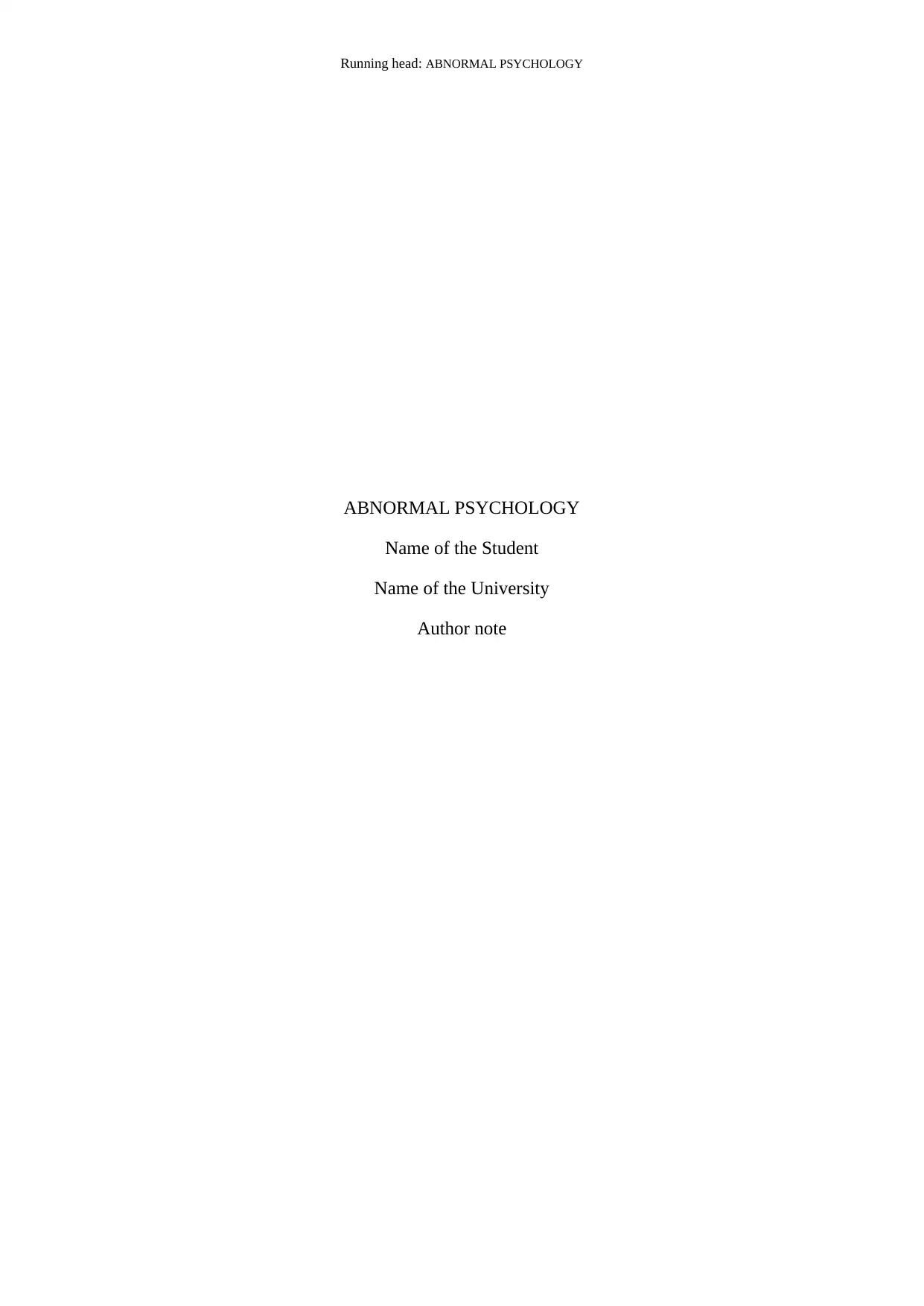
Running head: ABNORMAL PSYCHOLOGY
ABNORMAL PSYCHOLOGY
Name of the Student
Name of the University
Author note
ABNORMAL PSYCHOLOGY
Name of the Student
Name of the University
Author note
Paraphrase This Document
Need a fresh take? Get an instant paraphrase of this document with our AI Paraphraser
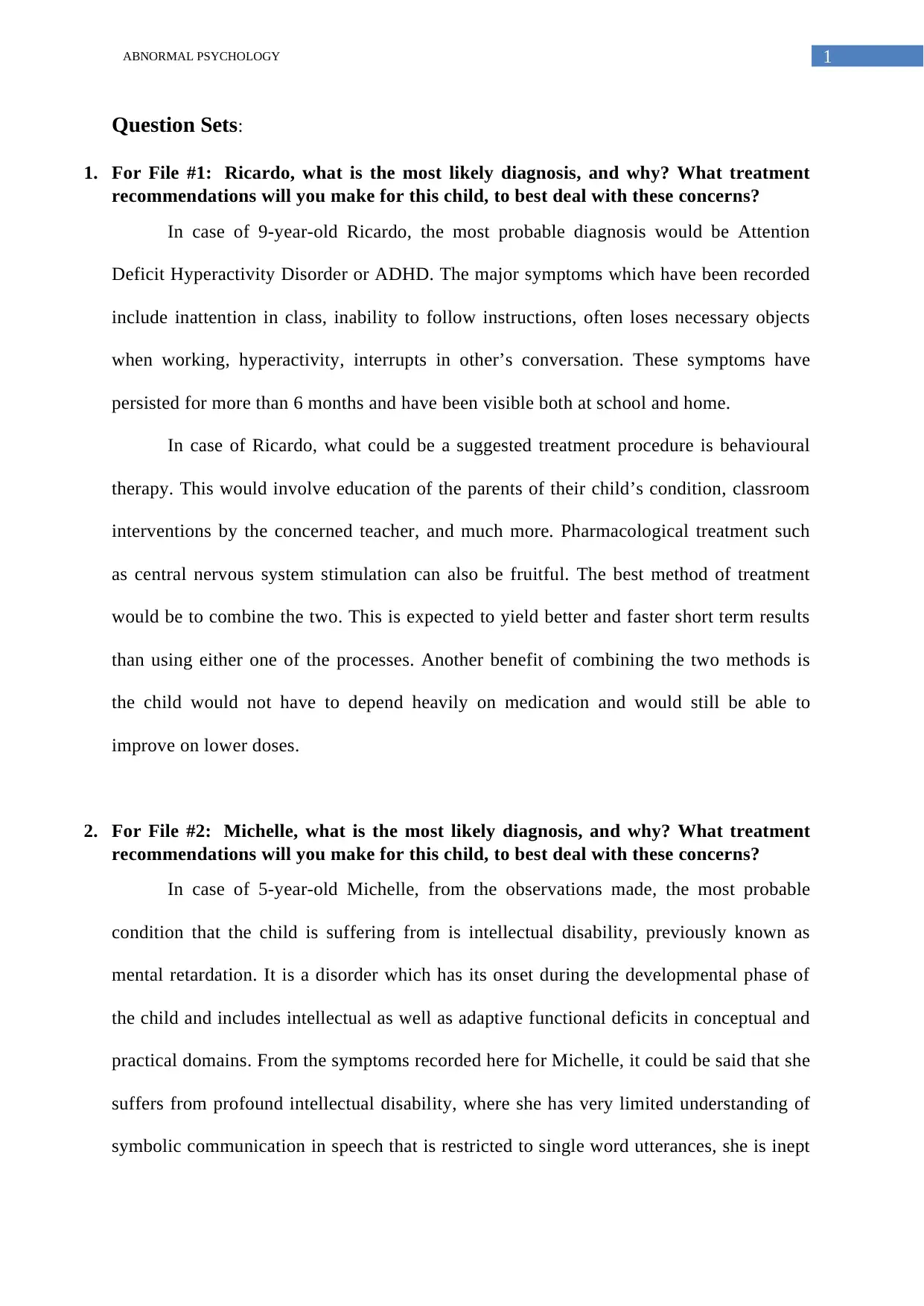
1ABNORMAL PSYCHOLOGY
Question Sets:
1. For File #1: Ricardo, what is the most likely diagnosis, and why? What treatment
recommendations will you make for this child, to best deal with these concerns?
In case of 9-year-old Ricardo, the most probable diagnosis would be Attention
Deficit Hyperactivity Disorder or ADHD. The major symptoms which have been recorded
include inattention in class, inability to follow instructions, often loses necessary objects
when working, hyperactivity, interrupts in other’s conversation. These symptoms have
persisted for more than 6 months and have been visible both at school and home.
In case of Ricardo, what could be a suggested treatment procedure is behavioural
therapy. This would involve education of the parents of their child’s condition, classroom
interventions by the concerned teacher, and much more. Pharmacological treatment such
as central nervous system stimulation can also be fruitful. The best method of treatment
would be to combine the two. This is expected to yield better and faster short term results
than using either one of the processes. Another benefit of combining the two methods is
the child would not have to depend heavily on medication and would still be able to
improve on lower doses.
2. For File #2: Michelle, what is the most likely diagnosis, and why? What treatment
recommendations will you make for this child, to best deal with these concerns?
In case of 5-year-old Michelle, from the observations made, the most probable
condition that the child is suffering from is intellectual disability, previously known as
mental retardation. It is a disorder which has its onset during the developmental phase of
the child and includes intellectual as well as adaptive functional deficits in conceptual and
practical domains. From the symptoms recorded here for Michelle, it could be said that she
suffers from profound intellectual disability, where she has very limited understanding of
symbolic communication in speech that is restricted to single word utterances, she is inept
Question Sets:
1. For File #1: Ricardo, what is the most likely diagnosis, and why? What treatment
recommendations will you make for this child, to best deal with these concerns?
In case of 9-year-old Ricardo, the most probable diagnosis would be Attention
Deficit Hyperactivity Disorder or ADHD. The major symptoms which have been recorded
include inattention in class, inability to follow instructions, often loses necessary objects
when working, hyperactivity, interrupts in other’s conversation. These symptoms have
persisted for more than 6 months and have been visible both at school and home.
In case of Ricardo, what could be a suggested treatment procedure is behavioural
therapy. This would involve education of the parents of their child’s condition, classroom
interventions by the concerned teacher, and much more. Pharmacological treatment such
as central nervous system stimulation can also be fruitful. The best method of treatment
would be to combine the two. This is expected to yield better and faster short term results
than using either one of the processes. Another benefit of combining the two methods is
the child would not have to depend heavily on medication and would still be able to
improve on lower doses.
2. For File #2: Michelle, what is the most likely diagnosis, and why? What treatment
recommendations will you make for this child, to best deal with these concerns?
In case of 5-year-old Michelle, from the observations made, the most probable
condition that the child is suffering from is intellectual disability, previously known as
mental retardation. It is a disorder which has its onset during the developmental phase of
the child and includes intellectual as well as adaptive functional deficits in conceptual and
practical domains. From the symptoms recorded here for Michelle, it could be said that she
suffers from profound intellectual disability, where she has very limited understanding of
symbolic communication in speech that is restricted to single word utterances, she is inept
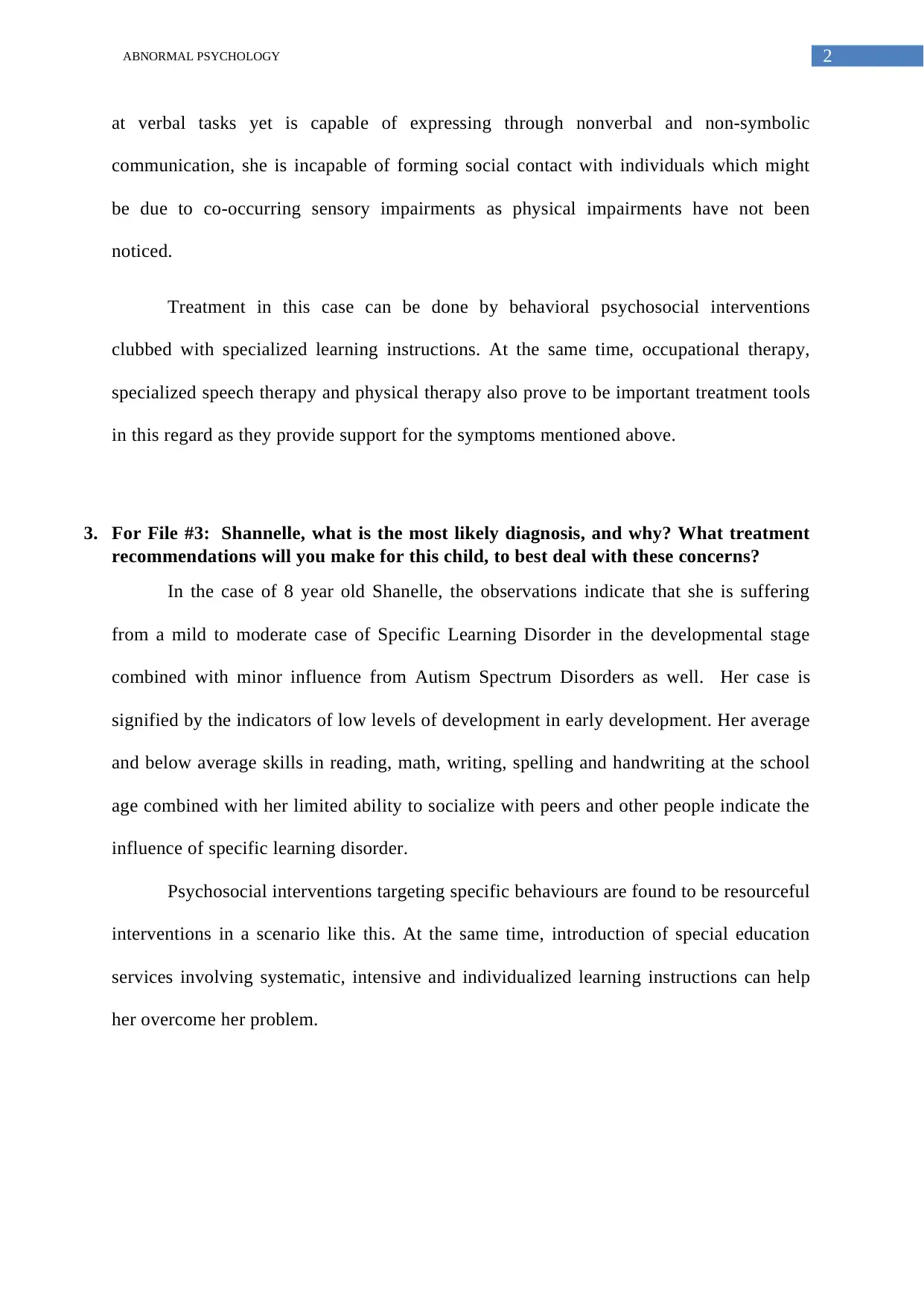
2ABNORMAL PSYCHOLOGY
at verbal tasks yet is capable of expressing through nonverbal and non-symbolic
communication, she is incapable of forming social contact with individuals which might
be due to co-occurring sensory impairments as physical impairments have not been
noticed.
Treatment in this case can be done by behavioral psychosocial interventions
clubbed with specialized learning instructions. At the same time, occupational therapy,
specialized speech therapy and physical therapy also prove to be important treatment tools
in this regard as they provide support for the symptoms mentioned above.
3. For File #3: Shannelle, what is the most likely diagnosis, and why? What treatment
recommendations will you make for this child, to best deal with these concerns?
In the case of 8 year old Shanelle, the observations indicate that she is suffering
from a mild to moderate case of Specific Learning Disorder in the developmental stage
combined with minor influence from Autism Spectrum Disorders as well. Her case is
signified by the indicators of low levels of development in early development. Her average
and below average skills in reading, math, writing, spelling and handwriting at the school
age combined with her limited ability to socialize with peers and other people indicate the
influence of specific learning disorder.
Psychosocial interventions targeting specific behaviours are found to be resourceful
interventions in a scenario like this. At the same time, introduction of special education
services involving systematic, intensive and individualized learning instructions can help
her overcome her problem.
at verbal tasks yet is capable of expressing through nonverbal and non-symbolic
communication, she is incapable of forming social contact with individuals which might
be due to co-occurring sensory impairments as physical impairments have not been
noticed.
Treatment in this case can be done by behavioral psychosocial interventions
clubbed with specialized learning instructions. At the same time, occupational therapy,
specialized speech therapy and physical therapy also prove to be important treatment tools
in this regard as they provide support for the symptoms mentioned above.
3. For File #3: Shannelle, what is the most likely diagnosis, and why? What treatment
recommendations will you make for this child, to best deal with these concerns?
In the case of 8 year old Shanelle, the observations indicate that she is suffering
from a mild to moderate case of Specific Learning Disorder in the developmental stage
combined with minor influence from Autism Spectrum Disorders as well. Her case is
signified by the indicators of low levels of development in early development. Her average
and below average skills in reading, math, writing, spelling and handwriting at the school
age combined with her limited ability to socialize with peers and other people indicate the
influence of specific learning disorder.
Psychosocial interventions targeting specific behaviours are found to be resourceful
interventions in a scenario like this. At the same time, introduction of special education
services involving systematic, intensive and individualized learning instructions can help
her overcome her problem.
⊘ This is a preview!⊘
Do you want full access?
Subscribe today to unlock all pages.

Trusted by 1+ million students worldwide
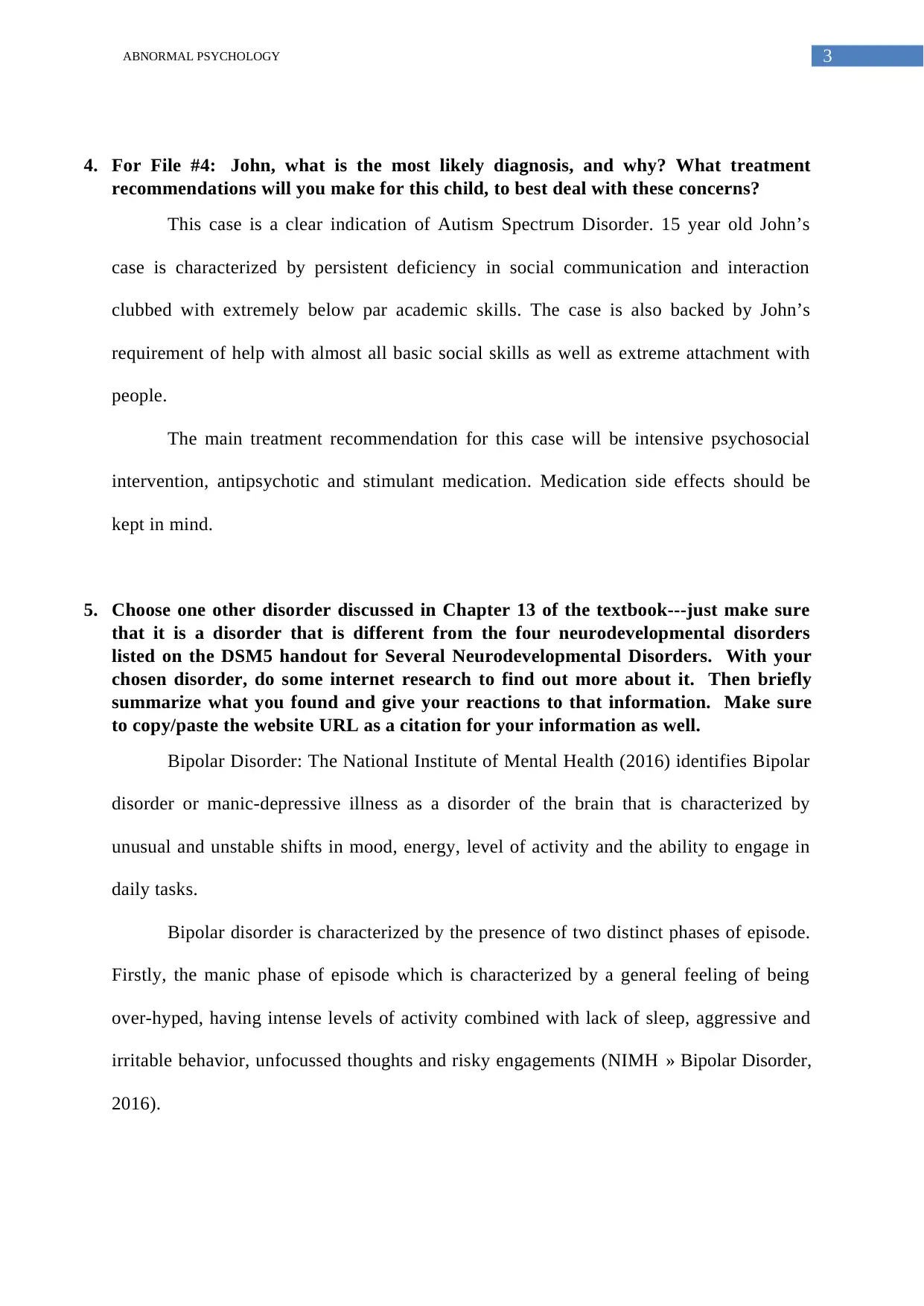
3ABNORMAL PSYCHOLOGY
4. For File #4: John, what is the most likely diagnosis, and why? What treatment
recommendations will you make for this child, to best deal with these concerns?
This case is a clear indication of Autism Spectrum Disorder. 15 year old John’s
case is characterized by persistent deficiency in social communication and interaction
clubbed with extremely below par academic skills. The case is also backed by John’s
requirement of help with almost all basic social skills as well as extreme attachment with
people.
The main treatment recommendation for this case will be intensive psychosocial
intervention, antipsychotic and stimulant medication. Medication side effects should be
kept in mind.
5. Choose one other disorder discussed in Chapter 13 of the textbook---just make sure
that it is a disorder that is different from the four neurodevelopmental disorders
listed on the DSM5 handout for Several Neurodevelopmental Disorders. With your
chosen disorder, do some internet research to find out more about it. Then briefly
summarize what you found and give your reactions to that information. Make sure
to copy/paste the website URL as a citation for your information as well.
Bipolar Disorder: The National Institute of Mental Health (2016) identifies Bipolar
disorder or manic-depressive illness as a disorder of the brain that is characterized by
unusual and unstable shifts in mood, energy, level of activity and the ability to engage in
daily tasks.
Bipolar disorder is characterized by the presence of two distinct phases of episode.
Firstly, the manic phase of episode which is characterized by a general feeling of being
over-hyped, having intense levels of activity combined with lack of sleep, aggressive and
irritable behavior, unfocussed thoughts and risky engagements (NIMH » Bipolar Disorder,
2016).
4. For File #4: John, what is the most likely diagnosis, and why? What treatment
recommendations will you make for this child, to best deal with these concerns?
This case is a clear indication of Autism Spectrum Disorder. 15 year old John’s
case is characterized by persistent deficiency in social communication and interaction
clubbed with extremely below par academic skills. The case is also backed by John’s
requirement of help with almost all basic social skills as well as extreme attachment with
people.
The main treatment recommendation for this case will be intensive psychosocial
intervention, antipsychotic and stimulant medication. Medication side effects should be
kept in mind.
5. Choose one other disorder discussed in Chapter 13 of the textbook---just make sure
that it is a disorder that is different from the four neurodevelopmental disorders
listed on the DSM5 handout for Several Neurodevelopmental Disorders. With your
chosen disorder, do some internet research to find out more about it. Then briefly
summarize what you found and give your reactions to that information. Make sure
to copy/paste the website URL as a citation for your information as well.
Bipolar Disorder: The National Institute of Mental Health (2016) identifies Bipolar
disorder or manic-depressive illness as a disorder of the brain that is characterized by
unusual and unstable shifts in mood, energy, level of activity and the ability to engage in
daily tasks.
Bipolar disorder is characterized by the presence of two distinct phases of episode.
Firstly, the manic phase of episode which is characterized by a general feeling of being
over-hyped, having intense levels of activity combined with lack of sleep, aggressive and
irritable behavior, unfocussed thoughts and risky engagements (NIMH » Bipolar Disorder,
2016).
Paraphrase This Document
Need a fresh take? Get an instant paraphrase of this document with our AI Paraphraser
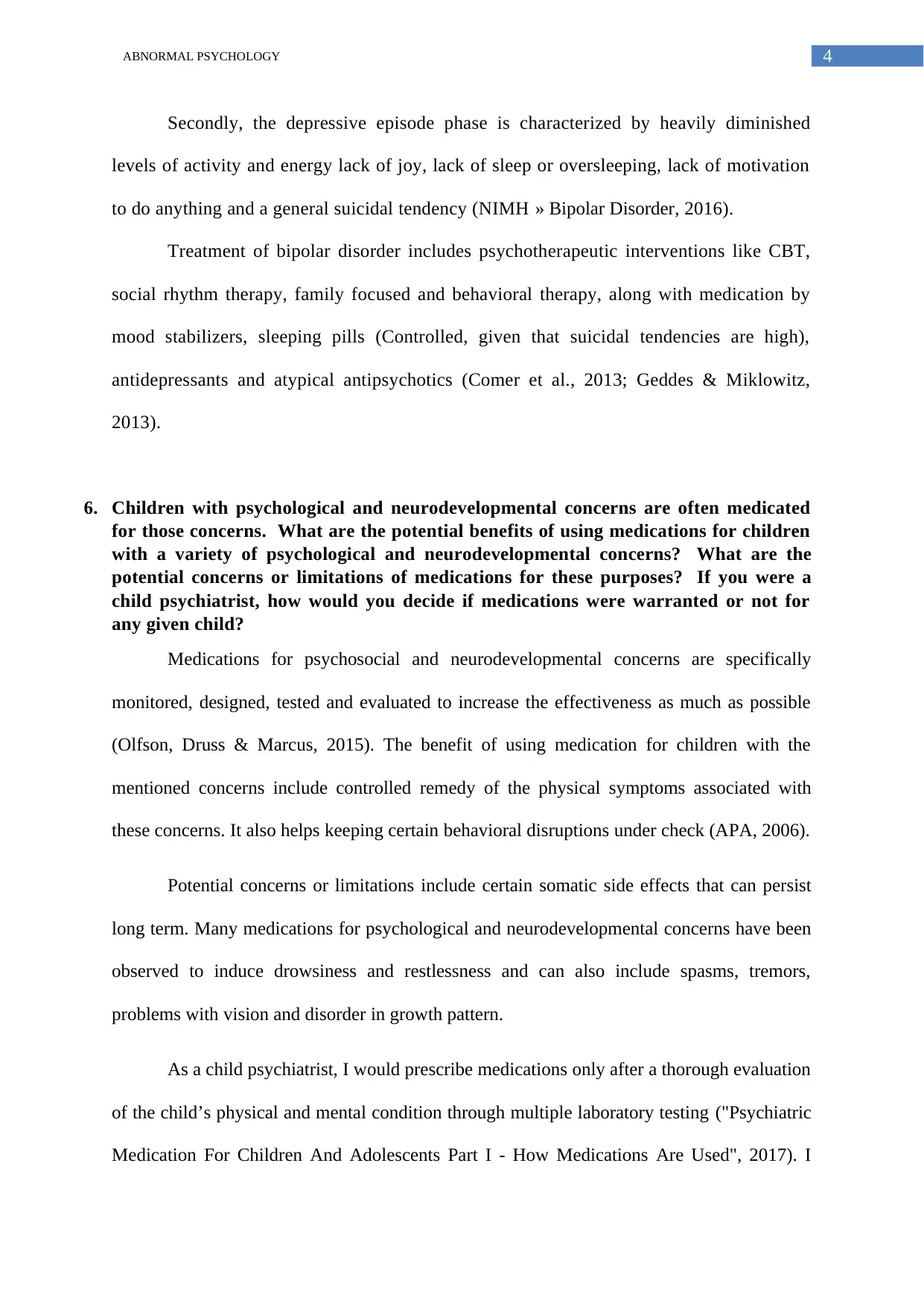
4ABNORMAL PSYCHOLOGY
Secondly, the depressive episode phase is characterized by heavily diminished
levels of activity and energy lack of joy, lack of sleep or oversleeping, lack of motivation
to do anything and a general suicidal tendency (NIMH » Bipolar Disorder, 2016).
Treatment of bipolar disorder includes psychotherapeutic interventions like CBT,
social rhythm therapy, family focused and behavioral therapy, along with medication by
mood stabilizers, sleeping pills (Controlled, given that suicidal tendencies are high),
antidepressants and atypical antipsychotics (Comer et al., 2013; Geddes & Miklowitz,
2013).
6. Children with psychological and neurodevelopmental concerns are often medicated
for those concerns. What are the potential benefits of using medications for children
with a variety of psychological and neurodevelopmental concerns? What are the
potential concerns or limitations of medications for these purposes? If you were a
child psychiatrist, how would you decide if medications were warranted or not for
any given child?
Medications for psychosocial and neurodevelopmental concerns are specifically
monitored, designed, tested and evaluated to increase the effectiveness as much as possible
(Olfson, Druss & Marcus, 2015). The benefit of using medication for children with the
mentioned concerns include controlled remedy of the physical symptoms associated with
these concerns. It also helps keeping certain behavioral disruptions under check (APA, 2006).
Potential concerns or limitations include certain somatic side effects that can persist
long term. Many medications for psychological and neurodevelopmental concerns have been
observed to induce drowsiness and restlessness and can also include spasms, tremors,
problems with vision and disorder in growth pattern.
As a child psychiatrist, I would prescribe medications only after a thorough evaluation
of the child’s physical and mental condition through multiple laboratory testing ("Psychiatric
Medication For Children And Adolescents Part I - How Medications Are Used", 2017). I
Secondly, the depressive episode phase is characterized by heavily diminished
levels of activity and energy lack of joy, lack of sleep or oversleeping, lack of motivation
to do anything and a general suicidal tendency (NIMH » Bipolar Disorder, 2016).
Treatment of bipolar disorder includes psychotherapeutic interventions like CBT,
social rhythm therapy, family focused and behavioral therapy, along with medication by
mood stabilizers, sleeping pills (Controlled, given that suicidal tendencies are high),
antidepressants and atypical antipsychotics (Comer et al., 2013; Geddes & Miklowitz,
2013).
6. Children with psychological and neurodevelopmental concerns are often medicated
for those concerns. What are the potential benefits of using medications for children
with a variety of psychological and neurodevelopmental concerns? What are the
potential concerns or limitations of medications for these purposes? If you were a
child psychiatrist, how would you decide if medications were warranted or not for
any given child?
Medications for psychosocial and neurodevelopmental concerns are specifically
monitored, designed, tested and evaluated to increase the effectiveness as much as possible
(Olfson, Druss & Marcus, 2015). The benefit of using medication for children with the
mentioned concerns include controlled remedy of the physical symptoms associated with
these concerns. It also helps keeping certain behavioral disruptions under check (APA, 2006).
Potential concerns or limitations include certain somatic side effects that can persist
long term. Many medications for psychological and neurodevelopmental concerns have been
observed to induce drowsiness and restlessness and can also include spasms, tremors,
problems with vision and disorder in growth pattern.
As a child psychiatrist, I would prescribe medications only after a thorough evaluation
of the child’s physical and mental condition through multiple laboratory testing ("Psychiatric
Medication For Children And Adolescents Part I - How Medications Are Used", 2017). I
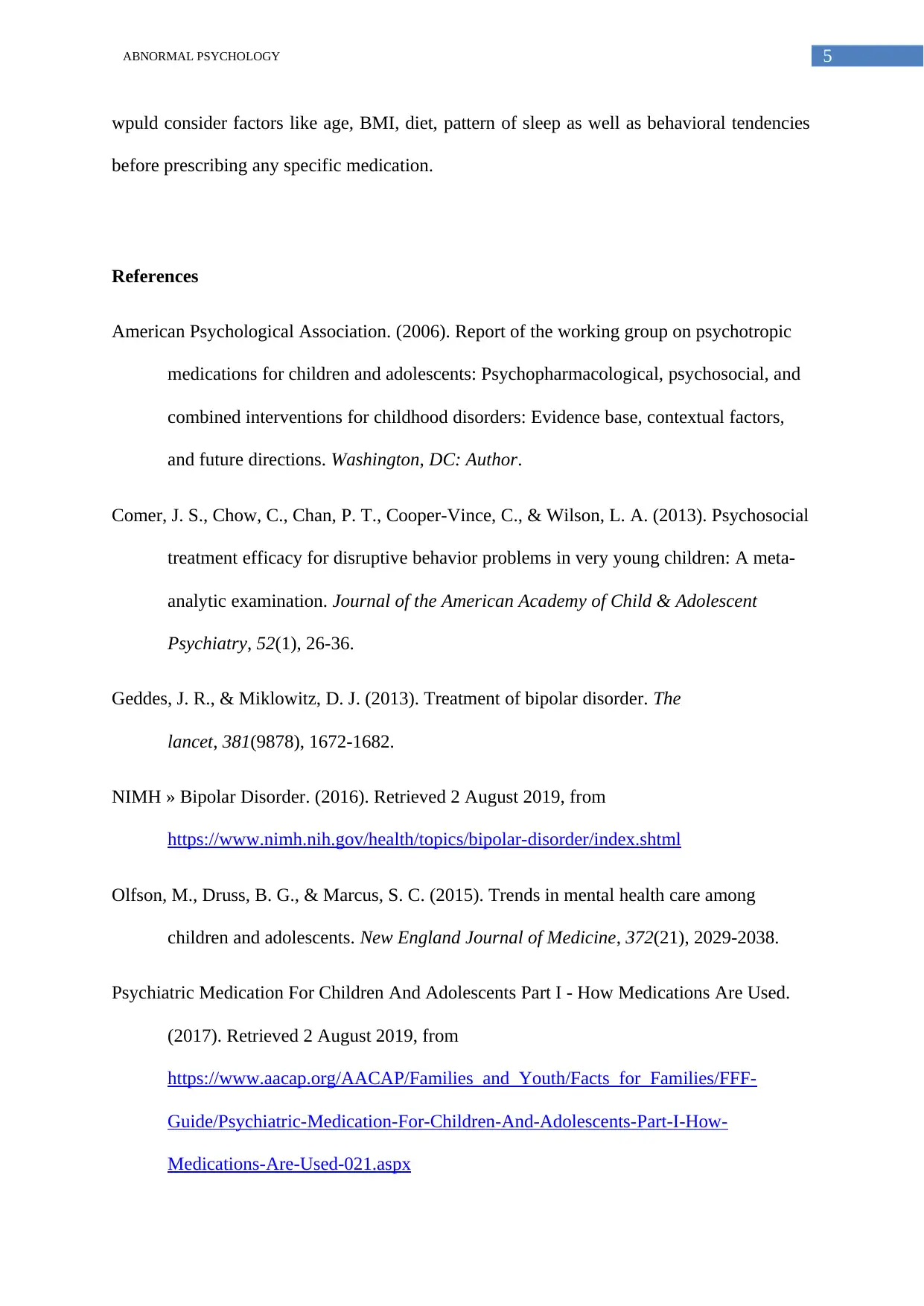
5ABNORMAL PSYCHOLOGY
wpuld consider factors like age, BMI, diet, pattern of sleep as well as behavioral tendencies
before prescribing any specific medication.
References
American Psychological Association. (2006). Report of the working group on psychotropic
medications for children and adolescents: Psychopharmacological, psychosocial, and
combined interventions for childhood disorders: Evidence base, contextual factors,
and future directions. Washington, DC: Author.
Comer, J. S., Chow, C., Chan, P. T., Cooper-Vince, C., & Wilson, L. A. (2013). Psychosocial
treatment efficacy for disruptive behavior problems in very young children: A meta-
analytic examination. Journal of the American Academy of Child & Adolescent
Psychiatry, 52(1), 26-36.
Geddes, J. R., & Miklowitz, D. J. (2013). Treatment of bipolar disorder. The
lancet, 381(9878), 1672-1682.
NIMH » Bipolar Disorder. (2016). Retrieved 2 August 2019, from
https://www.nimh.nih.gov/health/topics/bipolar-disorder/index.shtml
Olfson, M., Druss, B. G., & Marcus, S. C. (2015). Trends in mental health care among
children and adolescents. New England Journal of Medicine, 372(21), 2029-2038.
Psychiatric Medication For Children And Adolescents Part I - How Medications Are Used.
(2017). Retrieved 2 August 2019, from
https://www.aacap.org/AACAP/Families_and_Youth/Facts_for_Families/FFF-
Guide/Psychiatric-Medication-For-Children-And-Adolescents-Part-I-How-
Medications-Are-Used-021.aspx
wpuld consider factors like age, BMI, diet, pattern of sleep as well as behavioral tendencies
before prescribing any specific medication.
References
American Psychological Association. (2006). Report of the working group on psychotropic
medications for children and adolescents: Psychopharmacological, psychosocial, and
combined interventions for childhood disorders: Evidence base, contextual factors,
and future directions. Washington, DC: Author.
Comer, J. S., Chow, C., Chan, P. T., Cooper-Vince, C., & Wilson, L. A. (2013). Psychosocial
treatment efficacy for disruptive behavior problems in very young children: A meta-
analytic examination. Journal of the American Academy of Child & Adolescent
Psychiatry, 52(1), 26-36.
Geddes, J. R., & Miklowitz, D. J. (2013). Treatment of bipolar disorder. The
lancet, 381(9878), 1672-1682.
NIMH » Bipolar Disorder. (2016). Retrieved 2 August 2019, from
https://www.nimh.nih.gov/health/topics/bipolar-disorder/index.shtml
Olfson, M., Druss, B. G., & Marcus, S. C. (2015). Trends in mental health care among
children and adolescents. New England Journal of Medicine, 372(21), 2029-2038.
Psychiatric Medication For Children And Adolescents Part I - How Medications Are Used.
(2017). Retrieved 2 August 2019, from
https://www.aacap.org/AACAP/Families_and_Youth/Facts_for_Families/FFF-
Guide/Psychiatric-Medication-For-Children-And-Adolescents-Part-I-How-
Medications-Are-Used-021.aspx
⊘ This is a preview!⊘
Do you want full access?
Subscribe today to unlock all pages.

Trusted by 1+ million students worldwide

6ABNORMAL PSYCHOLOGY
1 out of 7
Related Documents
Your All-in-One AI-Powered Toolkit for Academic Success.
+13062052269
info@desklib.com
Available 24*7 on WhatsApp / Email
![[object Object]](/_next/static/media/star-bottom.7253800d.svg)
Unlock your academic potential
Copyright © 2020–2025 A2Z Services. All Rights Reserved. Developed and managed by ZUCOL.





